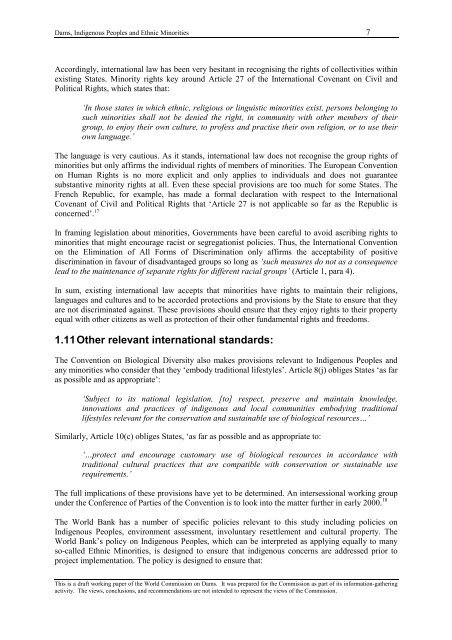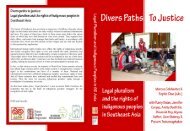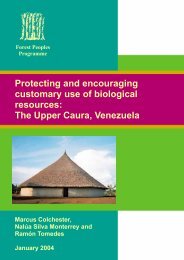Thematic Review II.2: Dams, Indigenous Peoples and Ethnic Minorities
Thematic Review II.2: Dams, Indigenous Peoples and Ethnic Minorities
Thematic Review II.2: Dams, Indigenous Peoples and Ethnic Minorities
Create successful ePaper yourself
Turn your PDF publications into a flip-book with our unique Google optimized e-Paper software.
<strong>Dams</strong>, <strong>Indigenous</strong> <strong>Peoples</strong> <strong>and</strong> <strong>Ethnic</strong> <strong>Minorities</strong> 7<br />
Accordingly, international law has been very hesitant in recognising the rights of collectivities within<br />
existing States. Minority rights key around Article 27 of the International Covenant on Civil <strong>and</strong><br />
Political Rights, which states that:<br />
‘In those states in which ethnic, religious or linguistic minorities exist, persons belonging to<br />
such minorities shall not be denied the right, in community with other members of their<br />
group, to enjoy their own culture, to profess <strong>and</strong> practise their own religion, or to use their<br />
own language.’<br />
The language is very cautious. As it st<strong>and</strong>s, international law does not recognise the group rights of<br />
minorities but only affirms the individual rights of members of minorities. The European Convention<br />
on Human Rights is no more explicit <strong>and</strong> only applies to individuals <strong>and</strong> does not guarantee<br />
substantive minority rights at all. Even these special provisions are too much for some States. The<br />
French Republic, for example, has made a formal declaration with respect to the International<br />
Covenant of Civil <strong>and</strong> Political Rights that ‘Article 27 is not applicable so far as the Republic is<br />
concerned’. 17<br />
In framing legislation about minorities, Governments have been careful to avoid ascribing rights to<br />
minorities that might encourage racist or segregationist policies. Thus, the International Convention<br />
on the Elimination of All Forms of Discrimination only affirms the acceptability of positive<br />
discrimination in favour of disadvantaged groups so long as ‘such measures do not as a consequence<br />
lead to the maintenance of separate rights for different racial groups’ (Article 1, para 4).<br />
In sum, existing international law accepts that minorities have rights to maintain their religions,<br />
languages <strong>and</strong> cultures <strong>and</strong> to be accorded protections <strong>and</strong> provisions by the State to ensure that they<br />
are not discriminated against. These provisions should ensure that they enjoy rights to their property<br />
equal with other citizens as well as protection of their other fundamental rights <strong>and</strong> freedoms.<br />
1.11 Other relevant international st<strong>and</strong>ards:<br />
The Convention on Biological Diversity also makes provisions relevant to <strong>Indigenous</strong> <strong>Peoples</strong> <strong>and</strong><br />
any minorities who consider that they ‘embody traditional lifestyles’. Article 8(j) obliges States ‘as far<br />
as possible <strong>and</strong> as appropriate’:<br />
‘Subject to its national legislation, [to] respect, preserve <strong>and</strong> maintain knowledge,<br />
innovations <strong>and</strong> practices of indigenous <strong>and</strong> local communities embodying traditional<br />
lifestyles relevant for the conservation <strong>and</strong> sustainable use of biological resources…’<br />
Similarly, Article 10(c) obliges States, ‘as far as possible <strong>and</strong> as appropriate to:<br />
‘…protect <strong>and</strong> encourage customary use of biological resources in accordance with<br />
traditional cultural practices that are compatible with conservation or sustainable use<br />
requirements.’<br />
The full implications of these provisions have yet to be determined. An intersessional working group<br />
under the Conference of Parties of the Convention is to look into the matter further in early 2000. 18<br />
The World Bank has a number of specific policies relevant to this study including policies on<br />
<strong>Indigenous</strong> <strong>Peoples</strong>, environment assessment, involuntary resettlement <strong>and</strong> cultural property. The<br />
World Bank’s policy on <strong>Indigenous</strong> <strong>Peoples</strong>, which can be interpreted as applying equally to many<br />
so-called <strong>Ethnic</strong> <strong>Minorities</strong>, is designed to ensure that indigenous concerns are addressed prior to<br />
project implementation. The policy is designed to ensure that:<br />
This is a draft working paper of the World Commission on <strong>Dams</strong>. It was prepared for the Commission as part of its information-gathering<br />
activity. The views, conclusions, <strong>and</strong> recommendations are not intended to represent the views of the Commission.

















